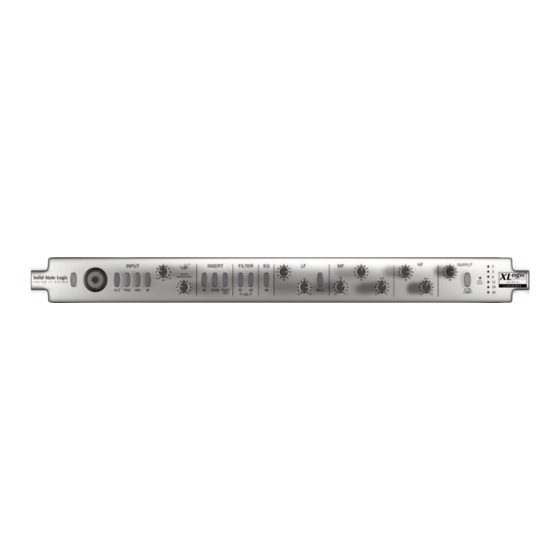Subscribe to Our Youtube Channel
Summary of Contents for Solid State Logic XLogic Alpha Channel
- Page 1 XLogic Alpha Channel XLogic Alpha Channel XLogic Alpha Channel XLogic Alpha Channel Putting it to work Putting it to work Putting it to work Putting it to work— — — — Tips & Tricks Tips & Tricks Tips & Tricks...
-
Page 2: Table Of Contents
XLogic Alpha Channel XLogic Alpha Channel XLogic Alpha Channel XLogic Alpha Channel Putting it to work Putting it to work— — — — Tips & Tricks Putting it to work Putting it to work Tips & Tricks Tips & Tricks Tips &... -
Page 3: Monitoring
Monitoring Monitoring Monitoring Monitoring A major consideration when recording into a host based DAW (Cubase, Logic, Sonar etc) is that there is always a latency associated with a signal passing through the software. In a DAW setup it is desirable for the musician and engineer (who may be the same person!) to monitor the signal before it reaches the computer audio interface. - Page 4 Analogue recording and monitoring cont’d... Analogue recording and monitoring cont’d... Analogue recording and monitoring cont’d... Analogue recording and monitoring cont’d... - The INSERT IN button should be down to enable the insert send. - The SUM button should be up as there is nothing connected to the insert return in this situation. - The POST EQ button should be up as we wish to record the non-EQ'ed signal.
-
Page 5: Digital Recording And Analogue Monitoring
Digital recording with analogue monitoring Digital recording with analogue monitoring Digital recording with analogue monitoring Digital recording with analogue monitoring If you prefer to use the digital output of the Alpha Channel to interface with your DAW but also need the analogue monitoring capabilities.. -
Page 6: Digital Clocking Considerations In The Studio
Digital clocking considerations in the studio Digital clocking considerations in the studio Digital clocking considerations in the studio Digital clocking considerations in the studio Please note that in order to use the S/PDIF output reliably, all digital devices in your studio should be synchronised from the same clock source. -
Page 7: Recording An Acoustic Source
Recording an Acoustic Source Recording an Acoustic Source Recording an Acoustic Source Recording an Acoustic Source Please refer to the first few sections of this tutorial to show the various monitoring configurations offered by the alpha channel. We will now assume that the full features of the channel are required to record an acoustic source such as vocals or acoustic guitar digitally into a DAW. -
Page 8: Recording Amplified Instruments
Recording Amplified Instruments Recording Amplified Instruments Recording Amplified Instruments Recording Amplified Instruments When recording an amped instrument (electric guitar, bass guitar, keyboards etc) it can be a good idea to take both a mic'ed signal from the cabinet and a DI signal directly from the instrument or amplifier. The Alpha Channel is capable of receiving these two signals and summing them in various ways to pro- vide a mono output source. - Page 9 Adding the DI signal: Adding the DI signal: Adding the DI signal: Adding the DI signal: - The direct signal either from a DI box or from the amplifier itself is input to the INSERT RETURN jack. Pressing the SUM button will add the mic and DI signal together. - The PHASE button can be used to alter the relative phase between the two signals.
-
Page 10: Processing A Pre-Recorded Signal Through The Alpha Channel
Processing a pre Processing a pre- - - - recorded signal through the Alpha Channel Processing a pre Processing a pre recorded signal through the Alpha Channel recorded signal through the Alpha Channel recorded signal through the Alpha Channel On mix down you may wish to use the Alpha Channels various functions to give signals the classic SSL analogue sound. -
Page 11: Using A Compressor In The Insert Send/Return Loop
Using a Compressor in the Insert send/return loop Using a Compressor in the Insert send/return loop Using a Compressor in the Insert send/return loop Using a Compressor in the Insert send/return loop It may be desirable at times to use a compressor to control the dynamic range of a signal which is being recorded. -
Page 12: Using Vhd
Using VHD Using VHD Using VHD Using VHD VHD – Variable Harmonic Drive is a unique feature of the Alpha Channel pre-amp. It allows a signal (mic or line) to be over driven from subtle harmonic colouration through to full on distortion characteris- tics. -
Page 13: Two Alpha Channels As A Stereo Pair
Two Alpha Channels as a stereo pair Two Alpha Channels as a stereo pair Two Alpha Channels as a stereo pair Two Alpha Channels as a stereo pair Any two or more Alpha Channels have the ability to be linked together. The two phono connections above the S/PDIF sockets labelled 'LINK' provide access to the side-chain of the Lite Limit circuit.


















Need help?
Do you have a question about the XLogic Alpha Channel and is the answer not in the manual?
Questions and answers